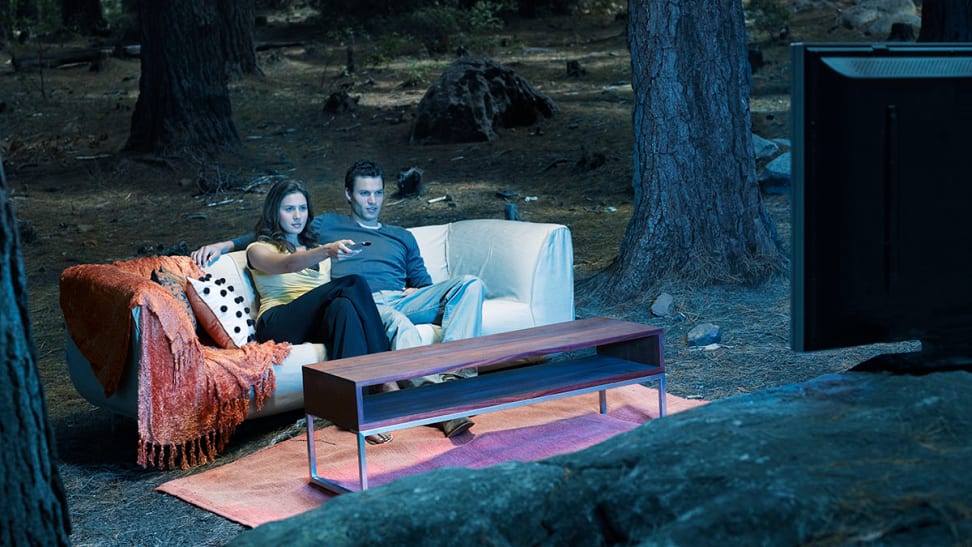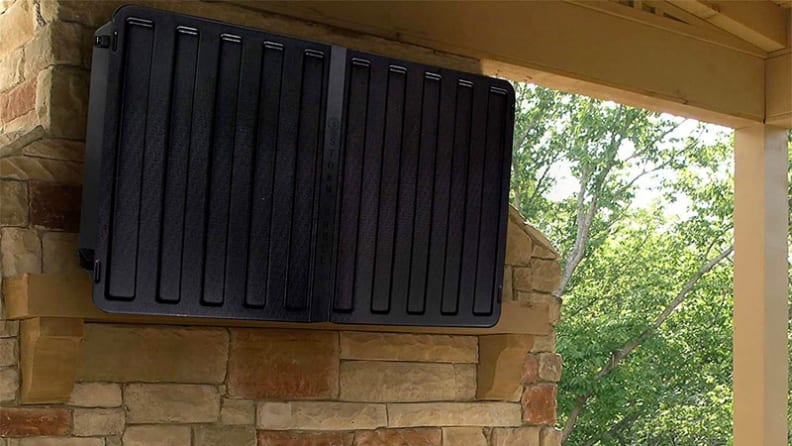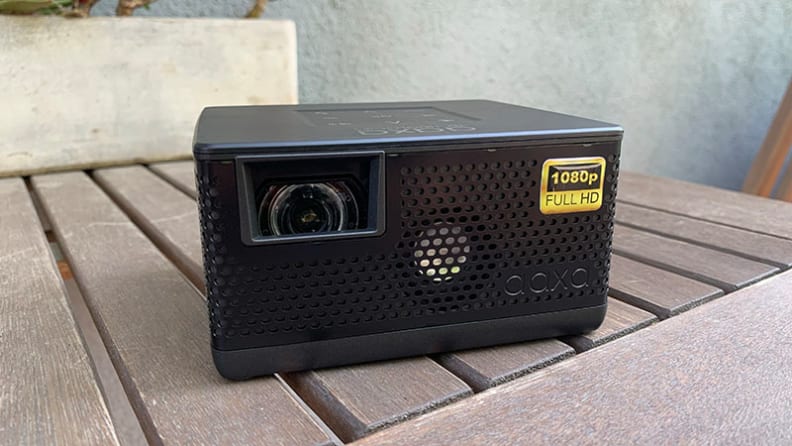Considering an outdoor TV? Here's what you need to know
Using your regular TV could work, if the situation is right
 Credit:
Credit:
Products are chosen independently by our editors. Purchases made through our links may earn us a commission.
There’s always a call to the outside during summer—doubly so the last couple of years as we look for a respite from quarantine protocols. But what about entertainment? Whether it’s enjoying the game while lounging by the pool, or enjoying some food on the patio while catching up on your favorite show, there’s something extra relaxing about watching TV outside.
Just grab the insanely bright QN90B or one of our other best TVs and mount it up under your patio cover, right? Hold up. While it’s possible, there are better ways to get outdoor entertainment, including TVs specifically designed for outside use. Getting the right one just takes planning. And usually a fair bit of money.
Why you should avoid putting your regular TV outdoors
While the thought of putting your living room TV out by the pool sounds like heaven, two big enemies to electronics lurk there as well. Namely, heat and moisture. With improved heatsinks and airflow, TV heat dissipation has come a long way over the years, but TVs still aren’t designed with the heat of the sun or outdoor moisture in mind.
For instance, the recommended operation range for Samsung’s indoor LCD TVs is 50° F to 104° F, while LG’s OLEDs can operate down to 32° F. Heat (or cold) beyond the operating range can have a negative impact on performance, causing pixels to respond incorrectly or shutting down the TV’s electronics. Temperature considerations should be taken into account both indoors and outdoors (e.g. don’t put your TV above the fireplace, please).
Then there’s moisture. Indoor TVs are not IP rated to withstand water. Condensation is an inevitability outdoors—not to mention splashes from the pool. Something drilled into us all since birth is that water and electronics do not mix because water is an excellent conductor of electricity. If a TV circuit board gets splashed with water, or even forms condensation in the wrong place, it creates an electrical connection that isn’t supposed to happen. At best, this shorts out the TV and it stops working. At worst, the short creates a spark and leads to a fire.
What is an outdoor TV?
Apart from cost, the primary factor that sets an outdoor TV apart from an indoor one is weather resistance. The chassis of outdoor TVs are designed to withstand ingress of both water and dust, indicated by their IP rating.
For example, the Samsung Terrace Full Sun outdoor TV can operate in external temperatures between -24° F and 122° F, and offers an IP55 rating meaning the TV is protected from dust (although not impervious) and water projected from a small nozzle from any direction for up to five minutes. Some TVs exceed that rating (higher numbers are better).
Now the issue with keeping water and dust out means the TVs are also keeping other things in, such as heat—and remember, extra heat and TV electronics are not friends. The brighter a TV gets, the more heat it generates. A lot of development time (and dollars) goes into improving heat dispersion so outdoor TVs perform at an optimal level. If an outdoor TV is on the lower end of the price spectrum, it’s because it doesn’t disperse heat as well and likely won’t be as bright.
You still need to consider outdoor TV placement. Just because it says “Outdoor TV” on the box, doesn’t mean it will survive out on an unprotected patio. Even outdoor TVs are complicated, delicate, and at times finicky. Manufacturers classify their TVs as full shade, partial shade, or full sun models. Pricing increases the more sun a TV can withstand, with full sun models sometimes costing twice as much as partial shade models. Buyer be warned, these classifications are not recommendations. Placing a full or partial shade model in direct sunlight will likely damage the TV eventually—and definitely void the warranty.
What are the best outdoor TVs?
Most of the outdoor TV manufacturer names are not widely known—such as Sunbrite, Element, and Furrion—while one, Samsung, is a household name. But no matter the name, you can expect to pay a premium for the outdoor functionality.
Even the cheapest option, the Element Partial Sun Roku TV will cost around $1,300, twice as much as you could pay for a comparable regular TV. Still, you get our favorite streaming platform in a 55-inch IP55 TV that puts out 700 nits of brightness. Not an incredible amount, but enough to hold up to ambient light and give HDR a little bit of pop.
Get the Element Roku TV at Walmart
For a smaller size, Furrion offers a 43-inch partial sun model that has 750 nits of brightness, an anti-glare screen, and is IP54 rated (so not as good against water). It comes in sizes up to 65 inches for around $2,500. The Aurora line also has a full shade option that is less expensive, but also only puts out 400 nits so the image is dimmer and HDR is lackluster.
Get the Furrion Aurora Partial Sun TV at Amazon
If you’re looking for the brightest outdoor TV possible, The Terrace from Samsung is for you. The partial sun version is available in 55-, 65-, and 75-inch sizes. It’s IP55 rated (the remote is IP56 rated), has Samsung’s Tizen OS for streaming services, and the QLED panel is capable of up to 2,000 nits of brightness. There’s also a matching soundbar to improve the audio quality (although I’d recommend any of the best soundbars we’ve tested). But this performance comes with a price. The partial sun sizes range from $3,500 to $6,500. And the full sun option, available in 65- and 75-inch, are a whooping $10,000 and $13,000.
Get The Terrace Partial Sun TV at Samsung
Can’t I just use a regular TV?

Outdoor TV enclosures, such as this one from Storm Shell, are available to protect a regular TV mounted outside.
Short answer: yes, with some considerations. As we’ve covered, the TV from your living room isn’t made to be put outside and survive. But there are ways to make it happen. Outdoor TV enclosures are available specifically for this purpose. They can range anywhere from $500 to over $1,000 and might incorporate a fan system to help with cooling or an articulating mount for viewing angle adjustment.
Other options include just plastic shells with a removable front when you want to watch. These offer protection only when the TV is stored and not when in use. Regardless, with any outdoor enclosure option it’s important to make sure to keep your TV fully in the shade.
Get the Storm Shell Outdoor TV cover at Amazon
What about a portable projector?

If you don't need a permanent setup outside, a portable projector is an excellent solution for quick outdoor entertainment.
If you’re not married to the idea of a TV outdoors and are looking to occasionally host an outdoor movie night, an affordable portable projector and screen might be the best option. The AAXA P400 is incredibly portable, has enough light output for a sizable picture after the sun’s gone down, and when paired with a screen is cheaper than many regular TVs. That said, it won’t deliver the same brightness or level of depth you’ll get from a TV.
Get the AAXA P400 portable projector at Amazon
For a brighter option, the BenQ HT2050A is a stalwart 1080p projector that can consistently be found for $700 or less. It delivers excellent picture quality for the price, and has enough light output to stand up to ambient light on the patio for screen sizes up to 120 inches.
To meet the 4K resolution of an outdoor TV, the Optoma UHD35 is hard to beat for the price. It’s over $1,000, but even when paired with a screen it’s significantly cheaper than most outdoor TVs. With low input lag that rivals TVs and support for high-refresh rate gaming (albeit limited to 1080p), the UHD35 brings epic gaming outdoors. Pair it with an excellent soundbar to complete the experience.
None of these projectors are IP rated, so you’ll need to keep them away from the pool, and direct sunlight will cause them to overheat—they are still electronics after all. But they’re easy to carry inside and store away. Or better yet, use them in your living room for big-screen entertainment indoors, too.
